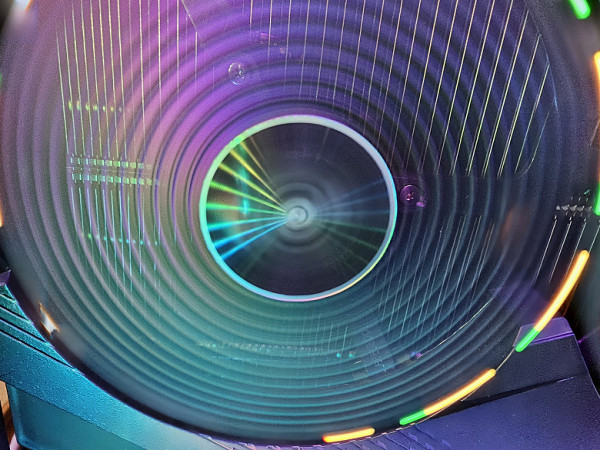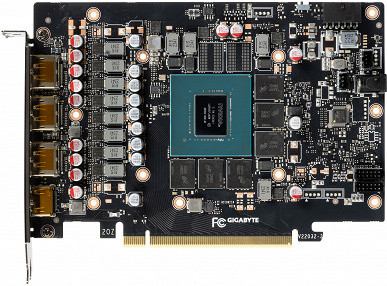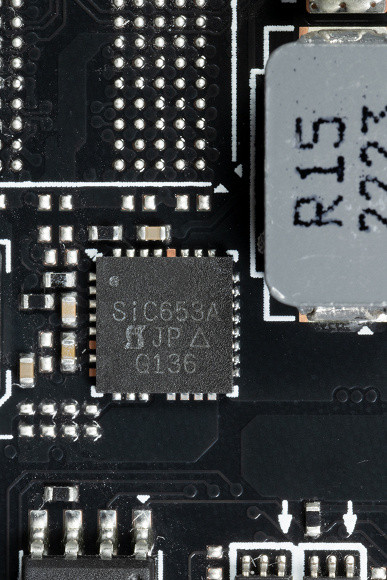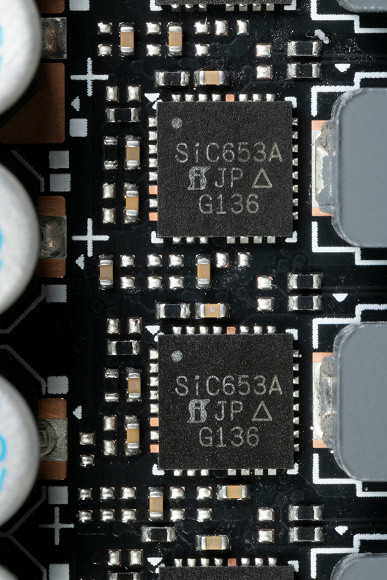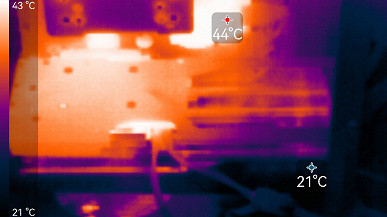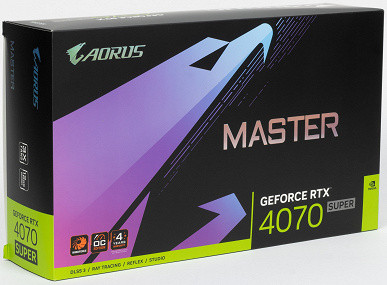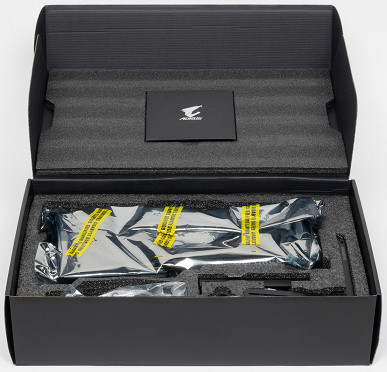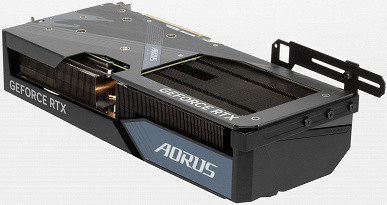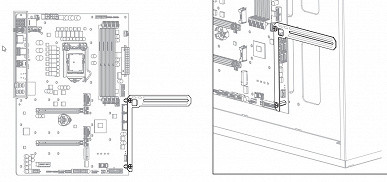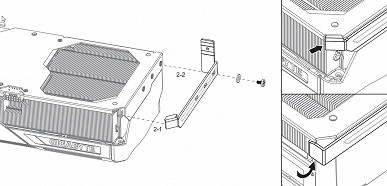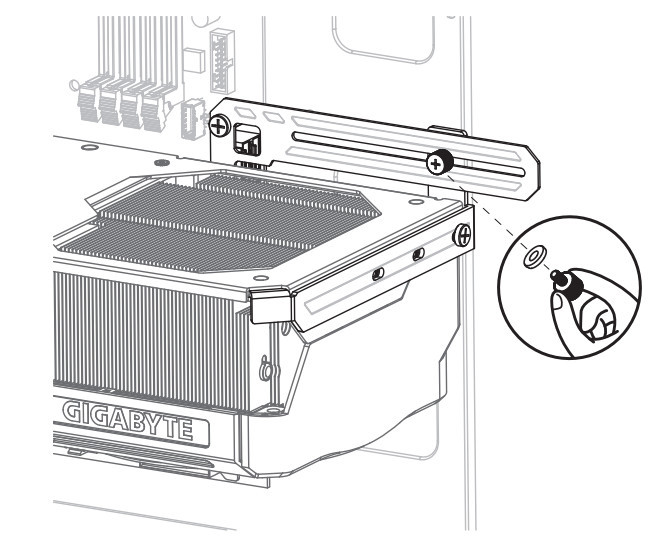
Research object: commercially available 3D graphics accelerator (video card) Gigabyte Aorus GeForce RTX 4070 Super Master 12G 12 GB 192-bit GDDR6
Briefly about the main thing
In our main review of the GeForce RTX 4070 Super, we took a closer look at why Nvidia decided to introduce an “intermediate” line of graphics accelerators. Ever since the release of the GeForce RTX 20 and GeForce GTX 1600, the Californian chipmaker introduced us to the Super suffix, which designated accelerators with performance levels between those without the suffix and those with the Ti suffix.
This is how the GeForce RTX 2060 Super, GeForce RTX 2070 Super (without Ti versions) and GeForce RTX 2080 Super (with the flagship version GeForce RTX 2080 Ti) appeared. There were also GeForce GTX 1660 Super, etc. Even then, discussions began about how obvious it was that Super was slower than Ti (many didn’t even know that Ti stood for Titanium). Previously, Pro and Ultra were used, and then it was clear that “ultra” was the fastest solution. But we have adopted a new nomenclature.
However, the GeForce RTX 30 generation did not have accelerators with the Super suffixes: initially there was a shortage of cards used for mining, and then the GeForce RTX 40 appeared. Now, in the new generation, there is a need for such solutions.
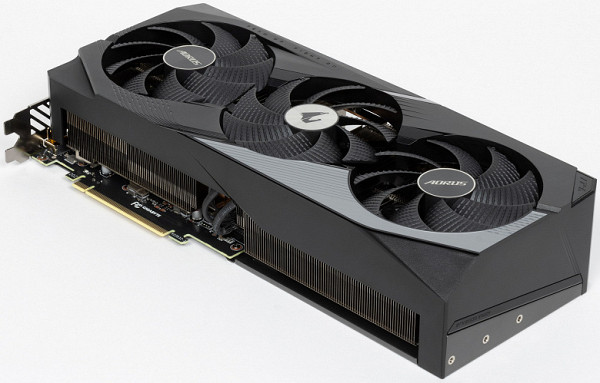
During the emergence of the first products of the GeForce RTX 40 generation, it was surprising to observe that in some cases the basic version of the accelerator (without Ti) and the version with Ti differed significantly in performance. If between the GeForce RTX 4080 and the GeForce RTX 4090 the question immediately arose about a future version like the GeForce RTX 4080 Ti (or Super), then the GeForce RTX 4070 could be called the GeForce RTX 4060 Ti — these cards turned out to be so weaker than the GeForce RTX 4070 Ti. By the way, in the GeForce RTX 30 generation, a similar difference was also observed — between the GeForce RTX 3060 and the GeForce RTX 3060 Ti (they even had different cores), and the release of the GeForce RTX 3060 Super was expected (given the GeForce RTX 3060 core cut down in blocks, it had potential to speed up).
In any case, we now have the GeForce RTX 4070, which remains on the market and is only getting cheaper, as well as the GeForce RTX 4070 Super, GeForce RTX 4070 Ti and GeForce RTX 4070 Ti Super. One of the latest options is at least leaving the market with the release of the GeForce RTX 4070 Ti Super at the same recommended prices, but now there is a significant gap again between the GeForce RTX 4070 Super and the GeForce RTX 4070 Ti Super in the absence of the GeForce RTX 4070 Ti .
As a result of the first studies, we see that the GeForce RTX 4070 Super is significantly more productive than the GeForce RTX 4070 version. Therefore, even taking into account the traditionally inflated prices for a new product, there are no problems when a new product is only a few percent ahead of the previous one, but costs ten percent more. other percent.
Today we are looking at the Aorus video card, a sub-brand of Gigabyte, with the addition of the proprietary Master suffix — which makes it the flagship variant of Aorus. The combination of Nvidia and Gigabyte suffixes is funny: GeForce RTX 4070 Super Master. Not just an owner, but a super owner :)
Before presenting detailed tests, we provide brief information about the performance of the family to which the accelerator under study belongs, as well as its competitors. We evaluate all this subjectively on a scale of seven gradations.
Games without ray tracing (classic rasterization):

Without resorting to Ray Tracing (RT) technology, the GeForce RTX 4070 Super provides excellent gaming fun at high graphics settings in three different resolutions. Some demanding games may experience a slight discomfort when only running at 4K resolution. The GeForce RTX 4070 Super successfully competes with the Radeon RX 7800 XT and the previous flagship Radeon RX 6950 XT.
As for the model from Gigabyte, thanks to the factory frequency increase, it has 3.5% higher performance compared to the reference accelerator (with an additional overclocking of 6%).
Games using ray tracing and DLSS/FSR/XeSS:

Enabling Ray Tracing (RT) technology reduces overall performance, but the image restoration technologies built into almost all games, such as Nvidia DLSS, AMD FSR (or even Intel XeSS), effectively compensate for the speed loss caused by using RT. Thus, for powerful video cards such as the GeForce RTX 4070 Super/Ti, the previously drawn conclusions regarding resolutions remain relevant. At the same time, they surpass even the latest generation flagship from AMD — Radeon RX 7900 XTX.
Card characteristics
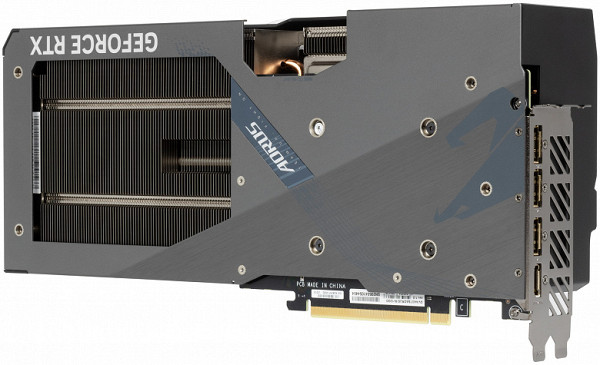

Gigabyte Technology Corporation (trademark Gigabyte) was established in 1986 in the Republic of China, Taiwan. The headquarters is located in Taipei/Taiwan. The company was originally created as a group of developers and researchers. In 2004, on the basis of this company, the Gigabyte holding was formed, which includes Gigabyte Technology (specializing in the development and production of video cards and motherboards for PCs) and Gigabyte Communications (engaged in the production of communicators and smartphones under the GSmart brand, since 2006).
| Gigabyte Aorus GeForce RTX 4070 Super Master 12G 12GB 192-bit GDDR6X | ||
|---|---|---|
| Parameter | Meaning | Nominal value (reference) |
| GPU | GeForce RTX 4070 Super (AD104) | |
| Interface | PCI Express x16 4.0 | |
| GPU operating frequency (ROPs), MHz | 2655(Boost)—2895(Max) | 2475(Boost)—2760(Max) |
| Memory operating frequency (physical (effective)), MHz | 2625 (21000) | 2625 (21000) |
| Memory bus width, bits | 192 | |
| Number of computational units in the GPU | 56 | |
| Number of operations (ALU/CUDA) in block | 128 | |
| Total number of ALU/CUDA blocks | 7168 | |
| Number of texturing units (BLF/TLF/ANIS) | 224 | |
| Number of rasterization units (ROP) | 80 | |
| Number of Ray Tracing blocks | 56 | |
| Number of tensor blocks | 224 | |
| Dimensions, mm | 340×155×70 | 300×130×55 |
| Number of slots in the system unit occupied by a video card | 4 | 3 |
| PCB color | black | black |
| Peak power consumption in 3D, W | 233 | 225 |
| Power consumption in 2D mode, W | 35 | 35 |
| Energy consumption in sleep mode, W | eleven | eleven |
| Noise level in 3D (maximum load), dBA (BIOS OC/Silent) | 34.0/27.2 | 31.0 |
| Noise level in 2D (video viewing), dBA | 18.0 | 18.0 |
| Noise level in 2D (idle), dBA | 18.0 | 18.0 |
| Video outputs | 1×HDMI 2.1, 3×DisplayPort 1.4a | 1×HDMI 2.1, 3×DisplayPort 1.4a |
| Multiprocessor support | No | |
| Maximum number of receivers/monitors for simultaneous image output | 4 | 4 |
| Power: 8-pin connectors | 0 | 0 |
| Power: 6-pin connectors | 0 | 0 |
| Power: 16-pin connectors | 1 | 1 |
| Weight of the card with delivery set (gross), kg | 2.55 | 2.0 |
| Card weight (net), kg | 1.7 | 1.2 |
| Maximum resolution/frequency, DisplayPort | 3840×2160@144 Hz, 7680×4320@60 Hz | |
| Maximum resolution/frequency, HDMI | 3840×2160@144 Hz, 7680×4320@60 Hz |
Memory
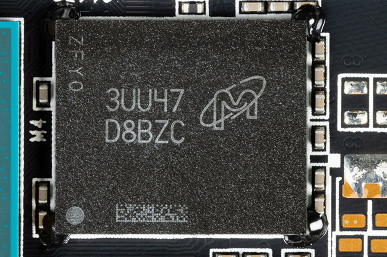
The graphics adapter is equipped with 12 GB of GDDR6X SDRAM video memory, located in six 16 Gbit chips on the front side of the PCB. The memory chips, in this case, are manufactured by Micron (MT61K512M32KPA-21/D8BZC) and are designed to operate at a nominal frequency of 2625 (21000) MHz.
Card features and comparison with Gigabyte Aorus GeForce RTX 4070 Ti Master (12 GB)
We are comparing this video card with an older model from the same manufacturer, taking into account the same physical cores. The analysis shows that the printed circuit boards of the less powerful and more powerful models are absolutely identical. The differences are only in the power phases and some logic elements.
The core of this card is marked AD104-350 (while the full-fledged chip used in the GeForce RTX 4070 Ti is marked at -400/401). Release date: 43rd week of 2023.
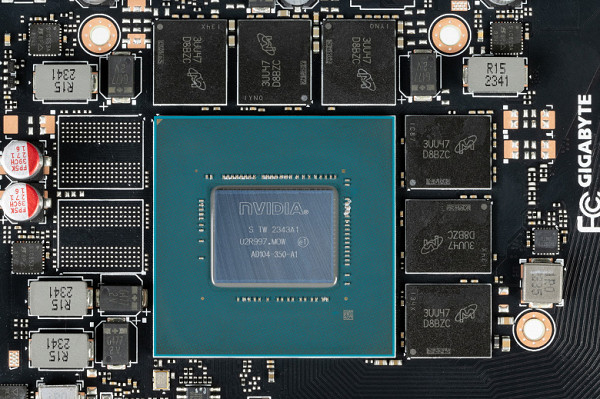
The number of power phases on the Gigabyte card in question is 12 (10+2), while the Gigabyte Aorus GeForce RTX 4070 Ti Master had 15 phases (12+3). Since the PCBs of both cards are identical, the new model simply provides space for three additional power phases.
On the power supply diagram, the core is highlighted in green, and the memory power supply diagram is highlighted in red.
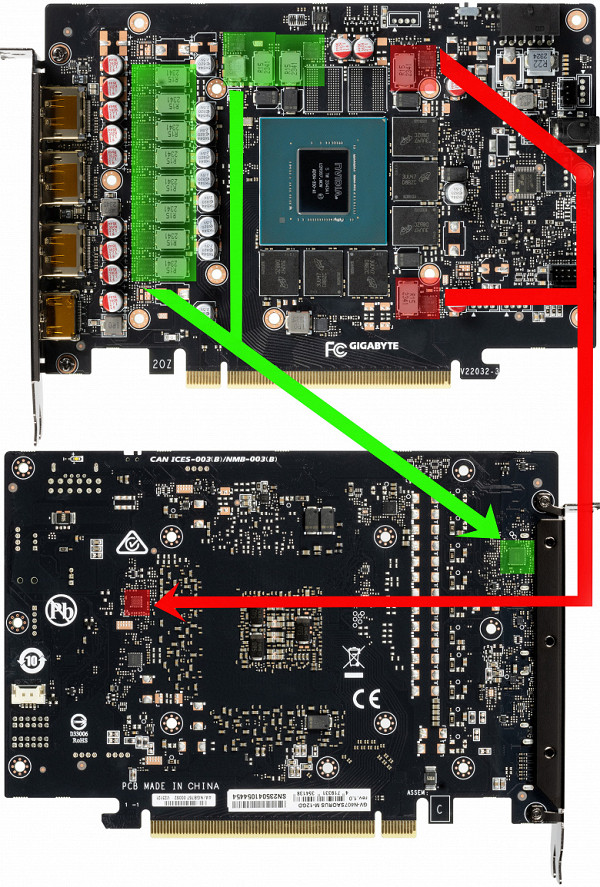
The 10 phases of core power are controlled by the uP9512R (uPI Semiconductor) PWM controller located on the reverse side of the PCB. It is designed for a maximum of 12 phases.
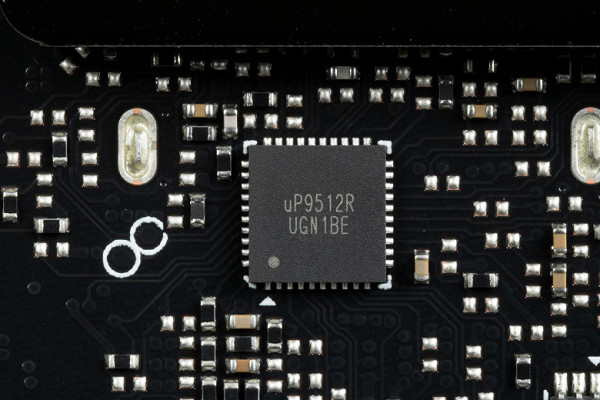
The power supply to the memory chips is controlled by the uP9529Q PWM controller (uPI Semiconductor), also located on the reverse side of the PCB.
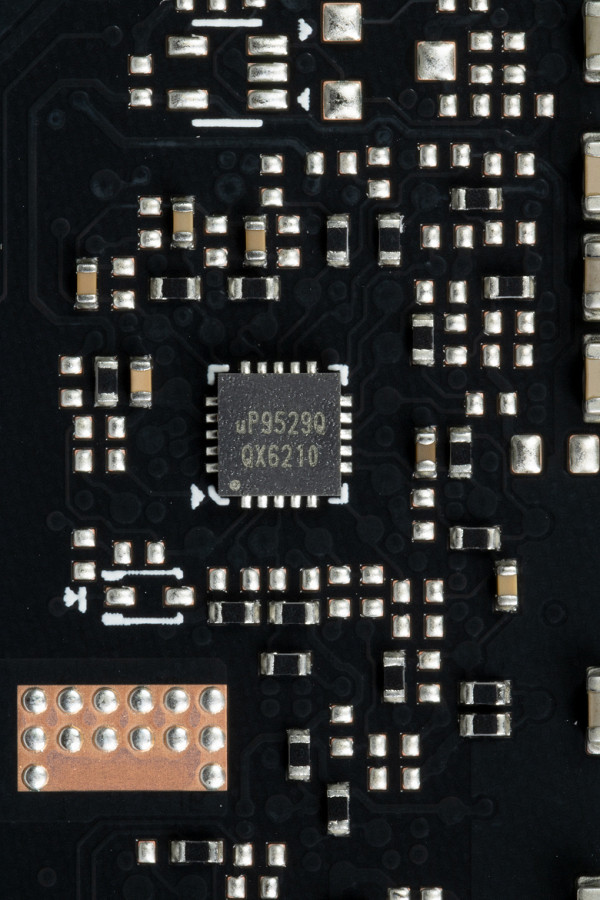
The power supply uses DrMOS transistor assemblies, which is standard practice for Nvidia video cards. In this case, SIC653A (Vishay Siliconix) are used, each of which is designed for a maximum current of up to 50 A.
On the back of the board there is a uS5650Q controller (uSI Semiconductor), which is responsible for monitoring the card (monitoring voltages and temperatures).
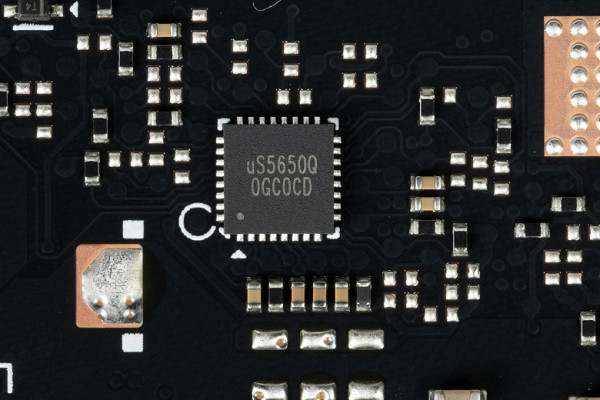
The task of controlling the backlight is assigned to the Holtek controller.
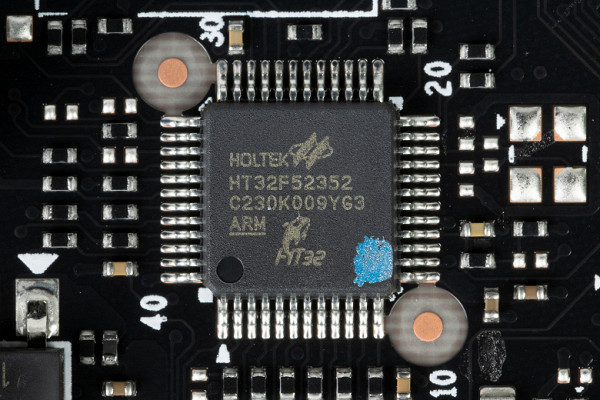
The video card is equipped with two operating modes, which are accessible through two BIOS options and are switched using a special switch on the top of the card: OC mode (increased performance) and Silent mode (silent operation of the cooling system). The difference between the modes lies solely in the fan settings.
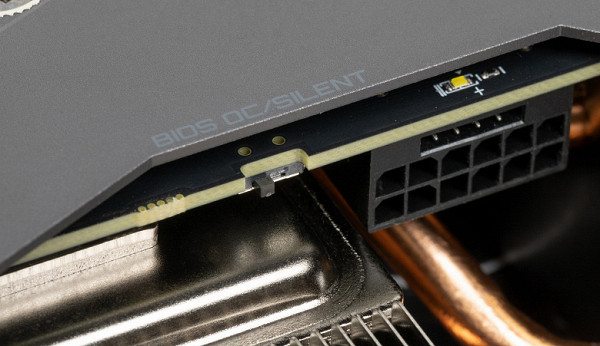
Memory frequencies in standard modes (BIOS OC and BIOS Silent) remain at the level of reference values. The maximum and accelerated core frequencies are also the same in both BIOS modes, exceeding the reference values by 7.2% and 4.8%, respectively. Research results show an average performance increase of 3.5% in games compared to the reference card (BPS remained at the same level).
The power consumption of the Gigabyte card in tests reaches 233/231 W (BIOS OC/Silent), and the maximum peak values are 265/262 W.
An experiment was carried out on manual overclocking (the consumption limit was raised to 142%), which led to the achievement of maximum frequencies of 3060/24000 MHz, which is 11% higher than the reference values. This resulted in an average 5.6% increase in gaming performance, while the card's power consumption increased to 243 W. The Gigabyte card is powered via a 16-pin PCIe 5.0 connector.

There is an indicator light near the power socket to indicate problems.
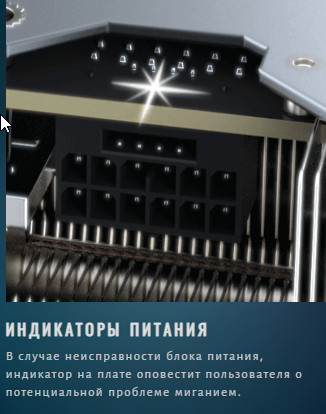
The card is supplied with an adapter for such a connector from two ordinary 8-pin ones (well known to everyone).
Despite the relatively low power consumption of this card and the low load on the adapter, we strongly recommend using full-fledged ATX 3.0 power supplies with a 12VHPWR connector and a cable that provides 16 pins for new generation video cards.
It is worth noting the significant dimensions of this video card, especially in thickness, which is 7 cm. As a result, it occupies 4 slots in the system unit.

The GeForce RTX 4070 Super does not support SLI multi-graphics configuration; there is no special connector on the top end of the card.
The video card is equipped with a standard set of video outputs: three DP 1.4a ports and one HDMI 2.1. The manufacturer provides high strength and quality of the printed circuit board, which is additionally protected by a special protective layer.
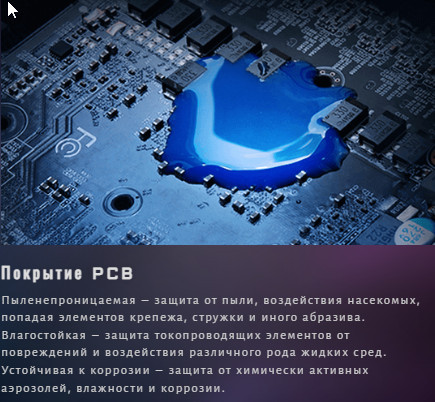
The card's operation is controlled using the familiar proprietary Gigabyte Control Center utility.
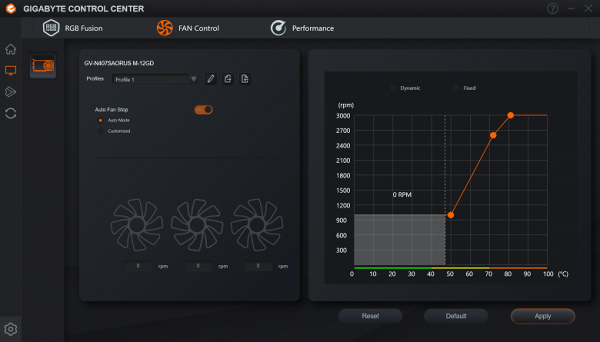
The utility provides control of fans, operating frequencies and core voltage, offers monitoring data and backlight control.
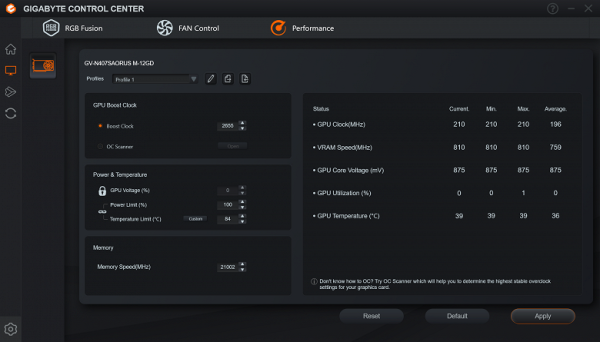
Heating and cooling
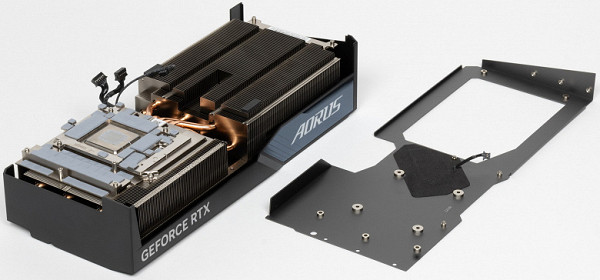
The Gigabyte video card uses a massive multi-section heatsink with nickel-plated plates, equipped with heat pipes for efficient heat distribution over the surface of the heatsink. The tubes are rigidly soldered to a large copper base, under which the evaporation chamber is located.
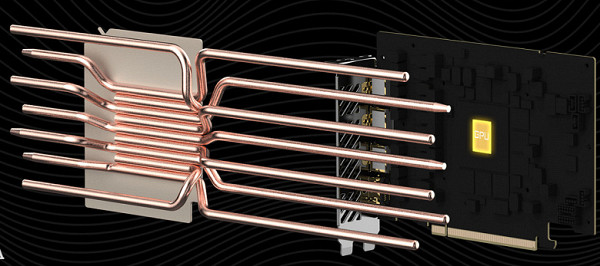
The massive heatsink's heatpipes and thermal pads are used to efficiently cool the memory chips, as well as ensure the VRMs are kept at optimal temperatures. The heatsink also features a separate soleplate to cool the VRM components.
The card's backplate is not designed to cool the back of the board; Its features include PCB protection and stiffening, and it also features an illuminated brand logo.

The radiator fins (through one) have bevels at the edges for greater air flow efficiency.
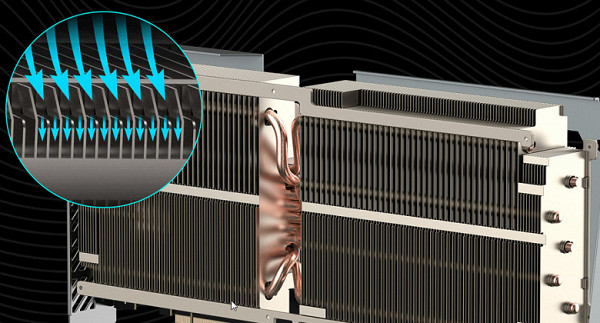
A casing with three ∅95 mm fans with grooved blades is installed on top of the radiator.
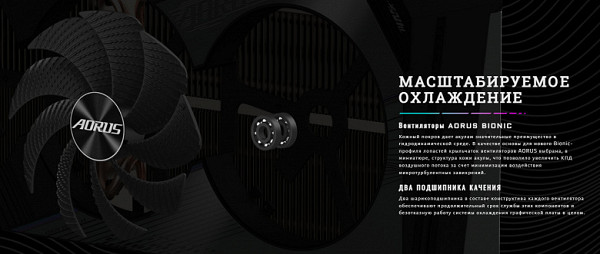
The technology of rotating the central fan in the opposite direction is no longer new and has been used in many models of the GeForce RTX 30 series. In theory, this approach can reduce air flow turbulence, which leads to more efficient cooling of all controllers and chips on the printed circuit board.
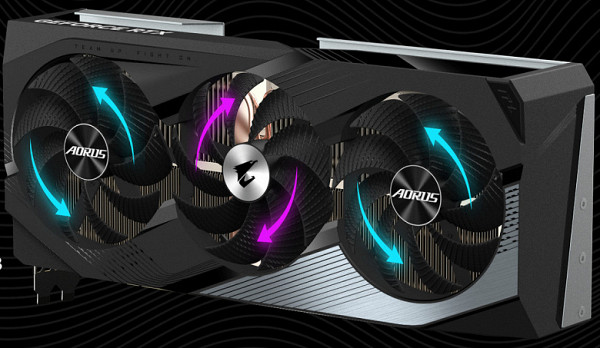
Stopping the fans when the graphics card is under low load is activated if the GPU temperature drops below 50 degrees, and the heating of the memory chips drops below 80 degrees. When the computer starts, the fans begin to function, but after loading the video driver, the operating temperature is checked, as a result of which they turn off. Below is a video about this feature.
Temperature monitoring:
BIOS 1(OC) mode:
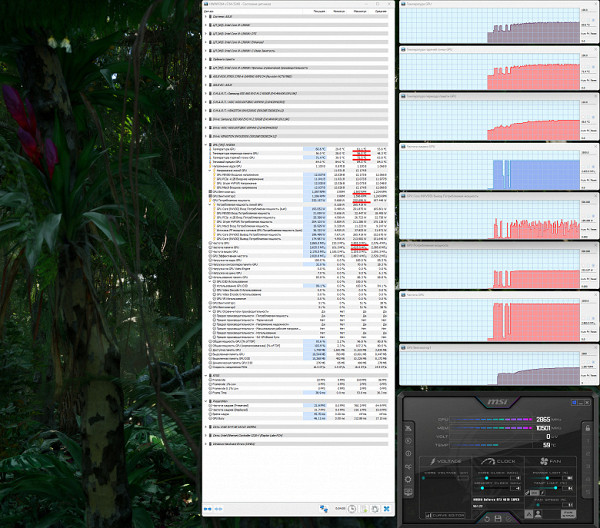
After two hours of testing at maximum load, the core temperature did not exceed 61 degrees (hot spot — 72°C), and the temperature of the memory chips was 56 degrees, which is considered an excellent indicator for video cards of this class. The card's power consumption reached 233 W (peak bursts up to 265 W). It is important to note that the safe temperature limit for GDDR6X memory is 105 °C.
The maximum heating was recorded near the PCIe connector.
We filmed and sped up 50 times an 8-minute warm-up (BIOS OC):
BIOS Mode 2(Silent):
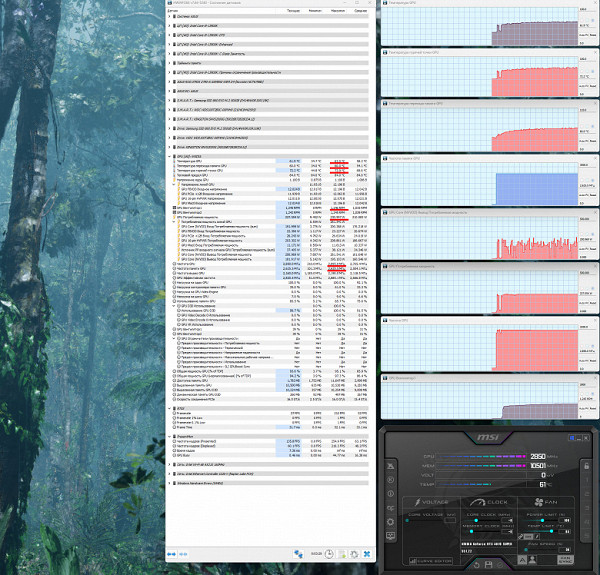
In this case, the maximum temperature of the core was 63 degrees, and the maximum temperature of the memory chips was 60°C, which is also considered an excellent result for video cards of this class. The card's power consumption remained virtually unchanged (231 W).
During manual overclocking (in BIOS Silent mode) with the consumption limit set at 142%, the heating parameters and noise level changed slightly (maximum core temperature reached 65 degrees, Hot spot — 77 °C, memory — 62 degrees), while consumption increased to 243 W (peak bursts up to 284 W).

Noise
The noise measurement technique assumes that the room is soundproofed and the reverberation level is reduced. The system unit in which the video card noise is measured does not have fans and is not a source of mechanical noise. The background noise level is 18 dBA — this is the noise level in the room and the level of the sound level meter. Measurements are taken at a distance of 50 cm from the video card at the level of the cooling system.
Measurement modes:
- Idle mode in 2D: an Internet browser with a website, a Microsoft Word window, and a number of Internet communicators are loaded.
- 2D mode with movie viewing: using SmoothVideo Project (SVP) — hardware decoding with insertion of intermediate frames.
- 3D mode with maximum load on the accelerator: using the FurMark test.
Assessment of noise level gradations:
- Less than 20 dBA: relatively silent.
- 20 to 25 dBA: very quiet.
- From 25 to 30 dBA: quiet.
- From 30 to 35 dBA: clearly audible.
- From 35 to 40 dBA: loud, but tolerable.
- Above 40 dBA: very loud.
In idle mode in 2D in both BIOS modes, the temperature was no higher than 33 °C, the fans did not work, and the noise level corresponded to the background level — 18 dBA.
When watching a movie with hardware decoding, nothing changed.
BIOS 1(OC) mode:
At maximum load in 3D mode, temperatures reached 61/72/56 °C (core/hot spot/memory). At the same time, the fans increased their speed to 1597 rpm, which led to a noise level of 34.0 dBA: it was clearly audible, already quite loud.
Using Gigabyte Control Center, you can reduce the fan speed, which will reduce the noise level, and, of course, the temperature will be higher, but the temperature margin is large.
The noise spectrogram revealed a small peak around 200 Hz, but it does not seem to be too pronounced audibly.

BIOS Mode 2(Silent):
At maximum load in 3D mode, temperatures reached 63/74/60 °C (core/hot spot/memory). At the same time, the fans increased their speed to 1246 rpm, the noise increased to 27.2 dBA: it was quiet. Considering that the noisier cooling mode allows you to save only a few degrees, and even in Silent mode the temperatures are far from critical, it is recommended to use BIOS 2 in most cases, unless there is a need for extreme overclocking.
Backlight
Brand logos are illuminated on the top edge and on the back of the card. In addition, there is lighting along the edges of the fan blades using LEDs located at their ends: it is activated only when the fans are rotating, and there is no glow when they stop.

Adjustment is carried out using Gigabyte Control Center software. An interesting backlight mode has been noticed, in which the speed of color changes corresponds to the rotation speed of the fans, especially at the edges of their blades.
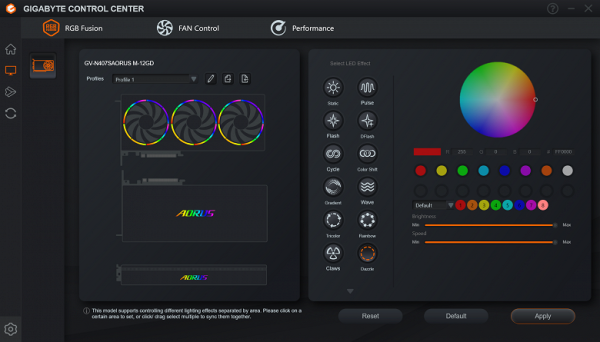
It is possible to save the selected mode in the card itself, that is, if you wish, you can configure the backlight once and not run the program again.

There is also a backlit logo on the screen at the top edge.
Delivery and packaging
The video card is supplied with a standard quick start guide, as well as additional accessories: a branded Aorus sticker, a dismountable metal stand-bracket for installing the card with a set of fasteners, and a power adapter.
There is not a tripod or even a support for the video card, but a bracket that can be mounted on the wall of the case outside the motherboard (when using the ATX form factor) or above it (in the case of the E-ATX form factor). Attachment is accomplished using the included mounting hardware kit.
The kit also includes a power adapter from two 8-pin connectors to one 16-pin connector. It is highly not recommended to bend the adapter in the place of the same braid!
conclusions
The Gigabyte Aorus GeForce RTX 4070 Super Master 12G (12GB) is an exciting addition to the family of high-end graphics cards available for less than RUB 100,000 at official retail stores. Equipped with all modern technologies for games, the card consumes up to 240 W of energy, has a silent cooling system (in BIOS Silent mode), while demonstrating moderate heating. However, its significant dimensions (34x15x7 cm) can occupy 4 slots in the case. The set of video outputs includes 3 DP and 1 HDMI ports. The card is connected via a 16-pin PCIe 5.0 power connector. Visually, the accelerator stands out with its original and stylish lighting, controlled through special software. The package includes a universal bracket for securely fixing the card in the case and preventing sagging when installed horizontally. The card comes with a factory core clock boost that brings it closer to the performance of the GeForce RTX 4070 Ti, justifying the higher price (compared to the regular GeForce RTX 4070 Super-based variants). In addition, it is not without visual appeal and has quiet operation. However, some users may find the absence of a full screen at the end, replaced by a glowing logo, insufficient.
The manufacturer provides a 4-year warranty for this card (subject to product registration on the company's official website).
Again, we emphasize that the GeForce RTX 4070 Super is ideal for gaming at resolutions up to 4K with maximum graphics levels in most classic games without the use of ray tracing technology. Even in the most graphics-intensive games at 4K resolution, a comfortable gaming situation may suffer slightly.
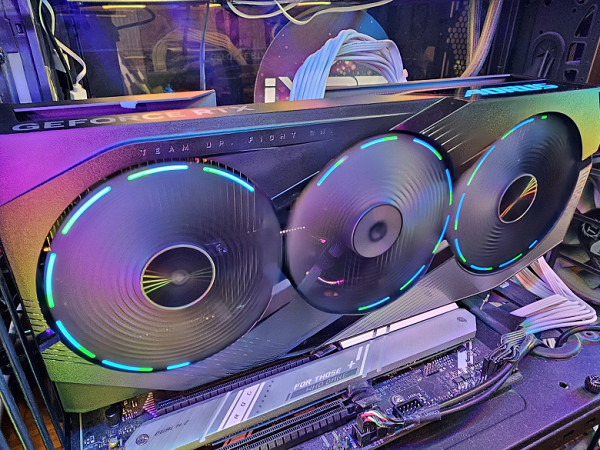
Likewise, the GeForce RTX 4070 Super is great for ray-traced gaming using DLSS/FSR/XeSS technologies, providing a great experience at 1080p and 1440p resolutions. Achieving a similar level of comfort at 2160p (4K) will require in-game support for DLSS 3. Without support for upscaling technologies, the comfort zone will be limited to 1440p (2.5K).
It is also worth noting support for the HDMI 2.1 standard, which allows you to output 4K images at 120 FPS or 8K resolution using a single cable. Other useful features include hardware decoding of AV1 video data, RTX IO technology for fast transfer and decompression of data from drives directly to the GPU, and Reflex technology for reducing latency, especially important for esports athletes. Don't forget that GeForce RTX 40 cards support the new version of DLSS 3.0, which uses the resolution scaling from DLSS 2 and doubles the frame rate using the Optical Flow Accelerator, enhanced by the Ada Lovelace architecture.
